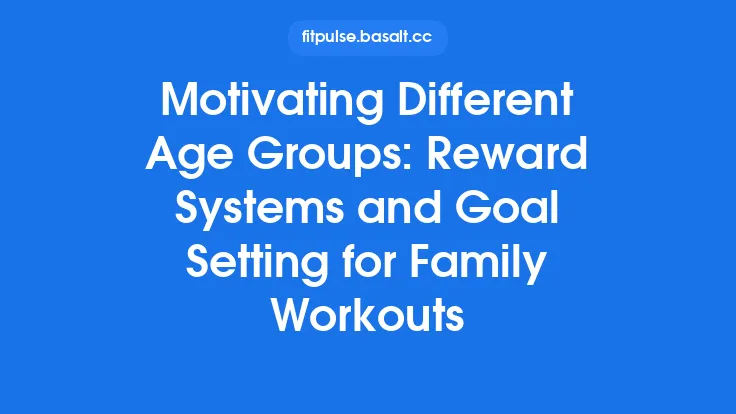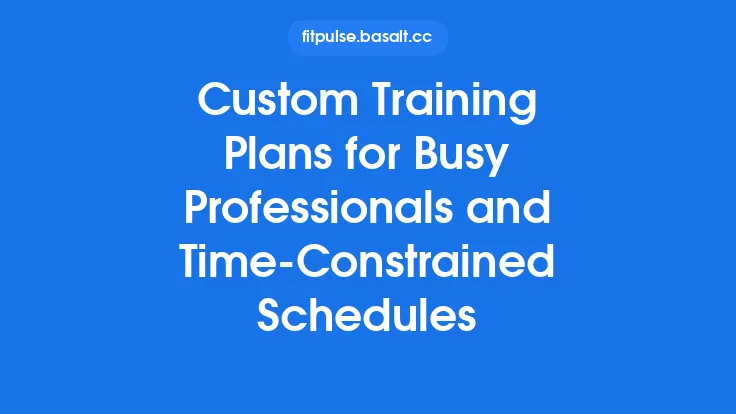When you train alone at home, the biggest invisible opponent is often yourself. Without the subtle pressure of a gym crowd, a scheduled class, or a workout buddy, it’s easy for motivation to drift, for sessions to be postponed, and for progress to stall. Accountability systems act as the external “hand‑on‑shoulder” that keeps you honest, motivated, and moving forward. Below is a deep dive into the most effective accountability mechanisms for solo home trainers—virtual partners, online communities, and structured challenges—and how to weave them into a seamless, evergreen support network.
Why Accountability Matters for Solo Home Trainers
- Psychological Commitment
When you publicly declare an intention—whether to a digital coach, a forum, or a challenge leaderboard—you create a cognitive contract. The brain registers this as a social promise, triggering a mild discomfort when you consider breaking it. This discomfort is a powerful driver to follow through.
- Behavioral Reinforcement
Accountability introduces immediate feedback loops. A virtual partner can flag missed sessions, a community can celebrate completed workouts, and a challenge can award points. These signals reinforce the desired behavior far more quickly than long‑term goal reflection alone.
- Reduced Decision Fatigue
Deciding whether to work out can become a mental hurdle. When an accountability system pre‑sets the “when” and “what,” you bypass the need for daily deliberation, conserving mental energy for the actual training.
- Social Proof and Norms
Seeing peers consistently train establishes a normative standard: “People like me are doing this.” This social proof nudges you to align with the group’s behavior, especially when the community is visible and active.
Virtual Partners: AI‑Powered Coaches and Real‑Time Feedback
1. Types of Virtual Partners
| Category | Core Functionality | Example Platforms |
|---|---|---|
| AI Chatbots | Text‑based prompts, schedule reminders, quick form checks | FitBot, MyFitnessPal Coach |
| Live Video Trainers | Real‑time video streaming, form correction via computer vision | Tempo Studio, Mirror |
| Sensor‑Driven Assistants | Wearable or device data (HR, reps) feeds into adaptive programming | Whoop, Polar Flow |
| Hybrid Systems | Combine AI chat with occasional live human check‑ins | Future, Tonal |
2. How Virtual Partners Create Accountability
- Scheduled Nudges: Calendar integration pushes notifications at pre‑set workout windows. The system can auto‑reschedule if you miss a slot, preserving the habit chain.
- Progress Check‑Ins: After each session, the partner asks for a brief self‑rating (e.g., “How hard was today’s workout?”). This forces reflection and logs data for future pattern analysis.
- Form Validation: Using computer vision, the system flags improper technique in real time, prompting immediate correction. Knowing you’ll be “watched” raises the stakes for each rep.
- Adaptive Difficulty: If you consistently miss sessions, the AI reduces intensity or shortens workouts to lower the barrier to entry, then gradually ramps back up—preventing burnout while maintaining commitment.
3. Technical Considerations
- Data Privacy: Choose platforms that encrypt video streams and store biometric data on secure servers. Look for GDPR or CCPA compliance statements.
- API Integration: For power users, many virtual partners expose RESTful APIs. You can pull session logs into a personal dashboard or combine them with other health data (sleep, nutrition) for a holistic view.
- Latency & Hardware: Real‑time video correction demands low latency and a decent GPU. If your internet connection is spotty, opt for AI chatbots that rely on text rather than video.
Building and Engaging with Online Communities
1. Community Formats
- Dedicated Forums: Structured threads for introductions, workout logs, Q&A. Example: Reddit r/homegym.
- Social Media Groups: Closed Facebook or Discord servers where members share daily updates, memes, and encouragement.
- Live Class Platforms: Zoom or proprietary streaming services that host scheduled group workouts, followed by a chat room for post‑class debriefs.
- Hybrid Membership Sites: Platforms like Fitocracy that blend gamified leaderboards with community discussion boards.
2. Leveraging Community Mechanics for Accountability
- Public Workout Logs: Posting a brief summary (“30‑min HIIT, 4 rounds”) creates a visible record. The community can comment, ask follow‑up questions, or simply give a thumbs‑up.
- Peer Pairing (Buddy System): Pair up with another member for weekly “check‑in calls.” The responsibility to report to a peer adds a personal layer of accountability.
- Themed Days: Communities often run “Leg Day Monday” or “Mobility Friday.” Participating in themed events aligns your schedule with the group’s rhythm.
- Recognition Badges: Earn digital badges for streaks (e.g., “7‑day streak”) that appear on your profile, reinforcing consistency through visual cues.
3. Managing Community Overload
- Notification Hygiene: Turn off non‑essential alerts; keep only “workout reminder” and “direct message” notifications active.
- Curated Feeds: Use platform filters to surface only posts from your chosen accountability partners or challenge groups.
- Time‑Boxed Interaction: Allocate a fixed 10‑minute window each day to scroll, comment, and log. This prevents the community from becoming a distraction rather than a support system.
Designing Effective Challenge Frameworks
1. Core Elements of a Challenge
| Element | Description | Why It Drives Accountability |
|---|---|---|
| Clear Objective | Specific metric (e.g., “Complete 150 push‑ups in 30 days”) | Removes ambiguity, sets a concrete target |
| Time‑Bound Structure | Defined start and end dates | Creates urgency and a natural deadline |
| Progress Tracking | Shared spreadsheet, app leaderboard, or badge system | Visualizes standing relative to peers |
| Reward System | Virtual trophies, discount codes, or community shout‑outs | Provides extrinsic motivation that can transition to intrinsic habit |
| Social Interaction | Weekly check‑ins, discussion threads, or live Q&A | Reinforces community bonds and peer pressure |
2. Types of Challenges
- Volume‑Based: Accumulate a total number of reps, minutes, or calories (e.g., “10,000 squat reps in 60 days”).
- Frequency‑Based: Hit a minimum number of sessions per week (e.g., “4 workouts per week for 8 weeks”).
- Skill‑Progression: Master a new movement by the end (e.g., “Achieve a full pistol squat”).
- Hybrid: Combine volume and skill (e.g., “Perform 5 sets of 10 burpees while maintaining perfect form”).
3. Implementing a Challenge Without Overcomplicating
- Select a Platform: Google Sheets for low‑tech, or a dedicated challenge app like Strava Challenges or Fitocracy for automated scoring.
- Define Rules Up‑Front: Clarify what counts as a valid entry (e.g., “Only recorded sessions with a heart‑rate monitor are eligible”).
- Assign a Moderator: One person (or a bot) validates entries, updates the leaderboard, and resolves disputes.
- Schedule Mid‑Challenge Check‑Ins: A brief virtual meetup to discuss progress, troubleshoot obstacles, and re‑energize participants.
- Celebrate Completion: Host a virtual “award ceremony” where winners receive digital certificates and the group shares success stories.
4. Psychological Levers
- Loss Aversion: Some challenges require a small entry fee (e.g., $5) that is refunded only upon completion. The prospect of losing money can boost adherence.
- Social Comparison: Leaderboards tap into the innate desire to rank, but ensure they are framed positively (e.g., “Most improved” rather than “Top performer”) to avoid discouragement.
Integrating Multiple Accountability Layers
A robust system often blends virtual partners, community interaction, and challenges. Here’s a step‑by‑step blueprint for a seamless integration:
- Morning Routine
- Virtual Partner sends a push notification at 7 am: “Ready for today’s 30‑min strength session?”
- Community: You post a quick “Starting now!” status in the group chat, tagging your accountability buddy.
- During the Workout
- Live Video Trainer (if available) monitors form, providing instant corrections.
- Wearable Sensor logs reps and heart‑rate, automatically feeding data to the challenge leaderboard.
- Post‑Workout
- Virtual Partner asks for a 1‑sentence reflection (“Felt strong on the deadlifts”).
- Community: You upload a screenshot of the session summary, earning a “Consistency” badge.
- Challenge: The system updates your cumulative total, showing your rank.
- Weekly Review
- Virtual Partner compiles a brief analytics report (total minutes, average intensity).
- Community: Participate in a Friday live call where members share wins and obstacles.
- Challenge: Moderator announces the current leaderboard and highlights any “most improved” participants.
- Monthly Reset
- Evaluate which accountability components are most effective (e.g., you may find the community check‑ins more motivating than the AI coach). Adjust the mix accordingly for the next month.
Common Pitfalls and How to Avoid Them
| Pitfall | Why It Happens | Mitigation Strategy |
|---|---|---|
| Over‑Automation | Relying solely on AI reminders can feel impersonal, leading to disengagement. | Pair each automated nudge with a human touch—e.g., a weekly message from a community moderator. |
| Social Overload | Constant notifications from multiple groups cause burnout. | Consolidate groups (e.g., one Discord server with separate channels) and set strict notification windows. |
| Leaderboard Anxiety | Seeing a low rank demotivates some users. | Use “progress‑based” leaderboards (e.g., most improved) rather than pure point totals. |
| Inconsistent Challenge Rules | Vague criteria lead to disputes and loss of trust. | Publish a concise rulebook before the challenge starts; appoint a neutral moderator. |
| Data Privacy Neglect | Sharing biometric data without safeguards can expose personal information. | Choose platforms with end‑to‑end encryption and clear data‑retention policies; regularly review permission settings. |
Choosing the Right Tools for Your Personality and Lifestyle
| Personality Trait | Ideal Accountability Mix | Recommended Tools |
|---|---|---|
| Social Butterfly | Heavy community involvement, frequent peer check‑ins | Discord fitness server, Facebook group, weekly Zoom class |
| Tech‑Savvy Analyst | AI coach with data dashboards, sensor integration | Tempo Studio, Whoop, custom API scripts |
| Competitive Spirit | Leaderboard‑driven challenges, gamified rewards | Fitocracy, Strava Challenges, MyFitnessPal “Streak” feature |
| Low‑Maintenance Preference | Minimal notifications, occasional nudges | Simple habit‑tracking app with push reminders (e.g., Habitica) |
| Privacy‑Conscious | Anonymous community, local data storage | Self‑hosted Nextcloud + Jitsi for video, offline wearable logs |
When selecting tools, consider:
- Device Compatibility – Ensure your smartphone, tablet, or smart TV can run the chosen app smoothly.
- Cost Structure – Many platforms offer free tiers; premium features (live AI coaching) may be worth the investment if they align with your accountability needs.
- Scalability – If you anticipate joining larger challenges later, pick a system that can grow with you (e.g., an app that supports both personal logs and group challenges).
Future Trends in Accountability for Home Fitness
- AI‑Generated Social Personas
Next‑generation virtual partners will simulate distinct personalities (e.g., “The Motivational Coach,” “The Technical Analyst”) that adapt to your mood, offering a more nuanced social experience.
- Decentralized Community Platforms
Blockchain‑based fitness networks promise true ownership of your data and reputation scores, allowing you to carry your accountability badge portfolio across apps.
- Mixed‑Reality Group Workouts
With affordable AR headsets, you’ll soon be able to see a holographic “classroom” of avatars performing the same routine, merging the social feel of a gym with the convenience of home.
- Predictive Drop‑out Prevention
Machine‑learning models will analyze patterns (e.g., missed sessions, heart‑rate variability) to proactively suggest interventions—like a “re‑engagement” video call—before motivation wanes.
- Integrated Wellness Ecosystems
Future platforms will tie fitness accountability to sleep, nutrition, and mental‑health metrics, delivering a holistic “well‑being score” that reflects overall lifestyle consistency.
Final Thoughts
Accountability is the connective tissue that transforms solitary home workouts into a sustainable, engaging practice. By thoughtfully combining virtual partners, vibrant online communities, and well‑designed challenges, you create a multi‑layered support system that:
- Keeps you honest through public commitments and real‑time feedback.
- Motivates you via social proof, gamified rewards, and adaptive coaching.
- Simplifies decision‑making by pre‑defining when, how, and with whom you train.
The key is to experiment, iterate, and align the accountability tools with your personal preferences, technical comfort, and privacy standards. When the right mix clicks, the once‑isolated home gym becomes a dynamic hub of interaction, encouragement, and measurable progress—ensuring that every rep, set, and session moves you closer to lasting fitness success.





